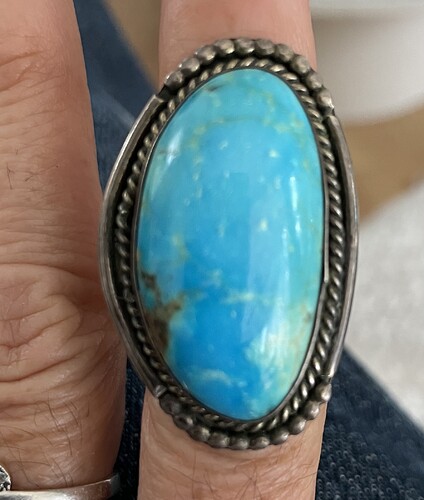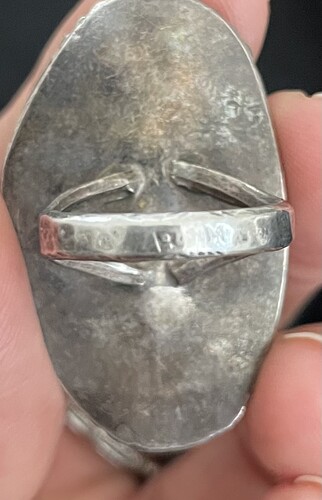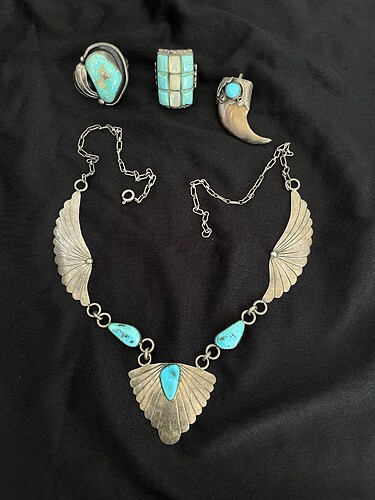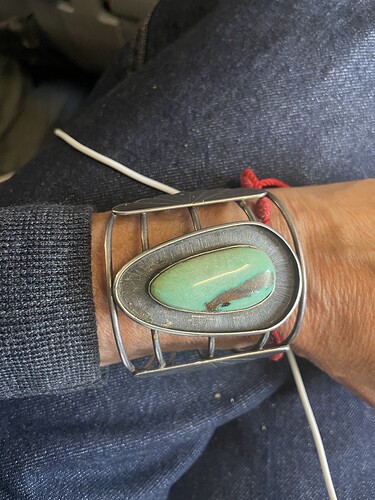Hello all, new to this site. I have quite a bit of old native jewelry I need help indentifying if real will start with this ring first. Thank you
Hi Anama, and welcome to the forum! Why don’t you introduce yourself, tell us a bit about where you’re from, how you came to own so much old Native jewelry, and what you know about the ring you’re posting.
Hi - yes thank you for asking. I was referred to this site by a friend who asked if I knew anything about my pieces. I don’t, so she suggested I reach out.
I bought most of them in one big chunk at an Estate sale in Florida over 20 years ago. At that time they were already labeled as old and I think the sellers didn’t really care for them. They were literally sitting in a plastic bag among a bunch of plastic jewelry and buttons etc.
Thanks so much for the welcome. I hope to learn more about my jewelry while here and also able to see other jewelry as well.
Can you get a clearer photo of the band?
Is there additional writing on the band or designs?
If I may make a suggestion, rather than posting piece by piece here on the site, I’d recommend making an appointment with a dealer specializing in Native jewelry and taking your collection in to them to look at. You’ll be able to cover quite a bit of ground in a short period of time that way.
That being said, the ring you posted looks like a production piece (made in job lots of ten or so, up to 100 at a time). Stone looks like inexpensive treated Arizona turquoise. No telling if it’s native made, or who made it beyond the initial on the back of the shank, which may have been added at any time. Also no indication that it’s an “antique”.
Trays full of this quality of merchandise were/are commonly available at stores, swap meets, flea markets and gun shows selling lower end reasonably priced southwestern jewelry.
Thanks. But I think I would like to hear from everyone about the pieces. It’s fun to hear opinions and maybe other people on here may know more? Thank you for your response.
Welcome to Turquoise People! I had no luck with this hallmark, and agree with @mmrogers’ assessment of it (he is extremely knowledgeable). But is pretty!
My advice on posting is to use separate posts for items or we may miss much of your stuff. This is a hobby for many of us, and I for one get overwhelmed when there are a bunch of items in one post.
You can learn a lot here if you dig in and read.
Edit Ahh I just saw the last post. Thank you ok understand.
Here are several more from the bulk of pieces to not post one by one. I won’t post anymore if you think I should just go elsewhere, I am curious and thought this was a place to explore and learn.
You can learn! But we aren’t official appraisers so if you need that we prob can’t help you with worth. And we can get a bit overwhelmed!
Ditto on this group of items as well. All production grade. Really common in the 70s through the early 80s.
Yes understood. I’m not looking for worth, I’ve had the collection for over 20 years and never bothered to find out anything about it until now that I started to wear them and people are asking questions. I’m clueless! lol
Great thank you! I won’t post anymore since it seems they are all real but with no history.
You can absolutely post them, but we may not always have the info you need to identify all of what you have. There are TONS and TONS of native american jewelry makers, and not all of them used unique hallmarks, or they made so little material in their career that they aren’t easily identifiable. the block-letter hallmark stamps can be bought at any jewelry supply and used by anyone, and there’s no master registry of who used what initials and what their jewelry style was to aid in identifying their work. it’s not just about hallmarks, but style and materials and techniques.
You might try posting one or two separate threads with groups of your collection, a handful at a time, say, rings only, or earrings only, clear group photos of fronts and backs, and you may get good info that way, if anyone sees something they recognize. Don’t take a lack of responses as disinterest - it may just be that no one has useful info to share.
Complicating things is that it is EXTREMELY difficult to identify turquoise from a specific mine, unless you have a documented provenance from the person that dug it out of the ground. Most mines produced an array of colors and matrix types, especially the larger or more productive mines (Kingman, i’m looking at you), that produced material easily (and wrongly) attributable to other mines.
You also have to consider the native american jewelry boom years of the 70s-80s, when EVERYONE was cranking out material to satisfy the enormous tourist demand. There were (and still are) whole manufacturing companies hiring native americans to crank out tourist-grade work. Then you have to sift through what the “hippie” or craft makers were creating to mimic native american work, combined with al the imports from asia that flooded (and still floods) the market. that’s a whole other can of worms. Some of the imports can be virtually indistinguishable from native american work, and some of them intentionally copy known makers styles and hallmarks.
I don’t see anything about the pieces you shared above that make me think they are imported, and would guess most of it lands somewhere in that 60s-80s time frame, as MMRogers said. most likely navajo, in my opinion.
that rectangle ring with the four dots on the shoulders - that split-shank is nice looking. it might be zuni, but i’d need much clearer pictures.

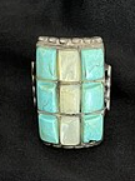
Most of us came here for the same reason as you, and stuck around to learn! I hope you do too. sorry for writing a dang ted talk! ![]()
This is wonderful thanks so much for your patience and lengthy response. I will follow your advice l. Yes, the ring photos, well mostly all of them seem way to light in color. I think my flash went off or the camera over adjusted. redo and resend. In any case it’s really super interesting to be here. I have spent some time browsing and reading.
I wasn’t sure about my pieces, as I said it was an estate sale a little over 20 years ago and literally paid like $20 for everything in a bag that they referred to as “old jewelry”.
One of the pieces in the same bag (not Native American) is an Elizabethan brooch from Spain, this was verified by an online dealer. This whole time just like some of the Native American jewelry I posted, I thought it was just costume or not anything real. I love stories behind objects and now that I’m older and wearing them it’s nice to try and find out.
In any case, thanks again. I appreciate the kindness.
The ring in the photo is a mass produced casting. Note the sprue mark on the side of the bezel above the split shank. These were produced in the 1000’s in the early/mid 70’s. They were everywhere for a while. I remember seeing plastic freezer containers full of these rings in the showroom of Thunderbird Jewelry where I worked as an independent wholesaler after leaving my position as shop production manager at Sunrise Traders (Thunderbird’s next door neighbor at the time).
I had a feeling it was a shop blank, and halfway expected it to have a bell hallmark somewhere. I still dig it! Wish it had better stones.
Ooh good observation, I saw those dents as well and figured they were scratches or emblems that may have fallen off.
I still have quite a few more pieces. I will post later. Thanks again!
Hi all again,
Ok I’m back again. Decided to just post when I wear them. Ok, here is another one from the bag. Any ideas? Is this another mass produced one? It has no markings, I polished the silver as best as I could. Thank you again ![]()
Oh my goodness. This is definitely eye catching IMO.
